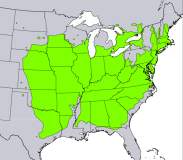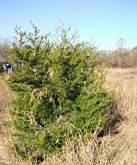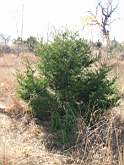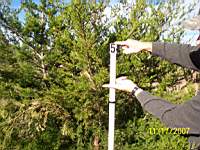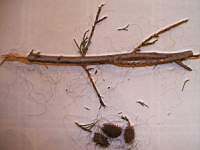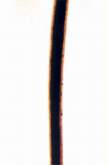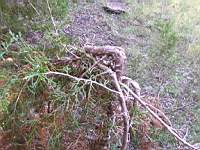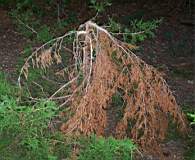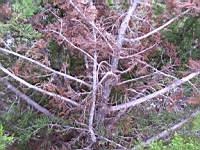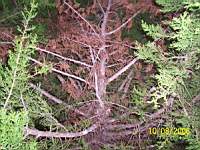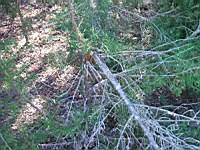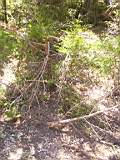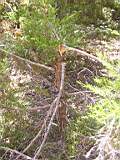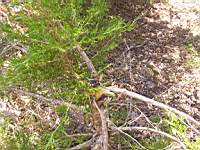Facts surroundng the Oklahoma Hair find:
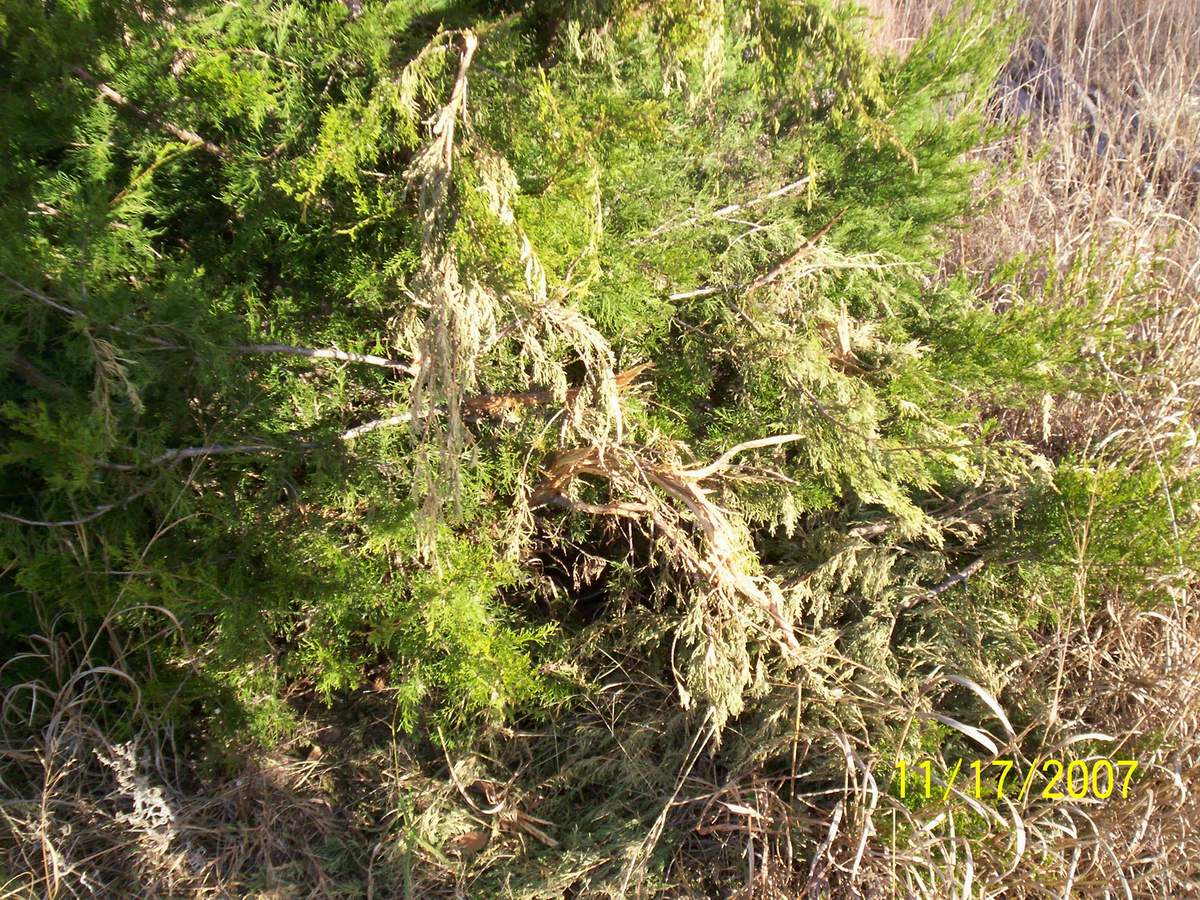
1. Three members of our team conducted a research outing to this area on recommendation of an acquaintance, that there were ongoing sightings in the area in question. There indeed is a history of purported sasquatch activity, to include sightings, tracks found and cast, photographs (not clear ones), video (not released to the public) and vocalizations heard.
2. The hairs were found the morning after our arrival to our campsite (11/17/2007). We began a casual scouting of the area in the morning shortly after day break as this was our first opportunity to have a look around. We shortly noticed an Eastern Red Cedar (Juniperus virginiana) tree near our camp that exhibited signs of fresh damage that did not appear weather related. The damage appeared very fresh, as the foliage on the broken limbs had just begun to wilt and turn dry. Later experimentation on this species of tree indicated that the damage was at a minimum 7 days old and likely not more than 3 weeks old.
3. The hairs were found dispersed on this tree at heights to slightly above 4 ft. off the ground and numerous hairs were found on the limbs that exhibited damage. In some instances, the hairs were snagged deeply in the splintered breaks indicating that the donor of the hairs had also done the damage.
4. During our investigation of the find, five cockle burrs were found on the ground below the limb breaks, with the same type of hair wrapped around them, indicating that the animal had managed to sluff off or deliberately removed the burrs from itís coat in an act of self grooming.
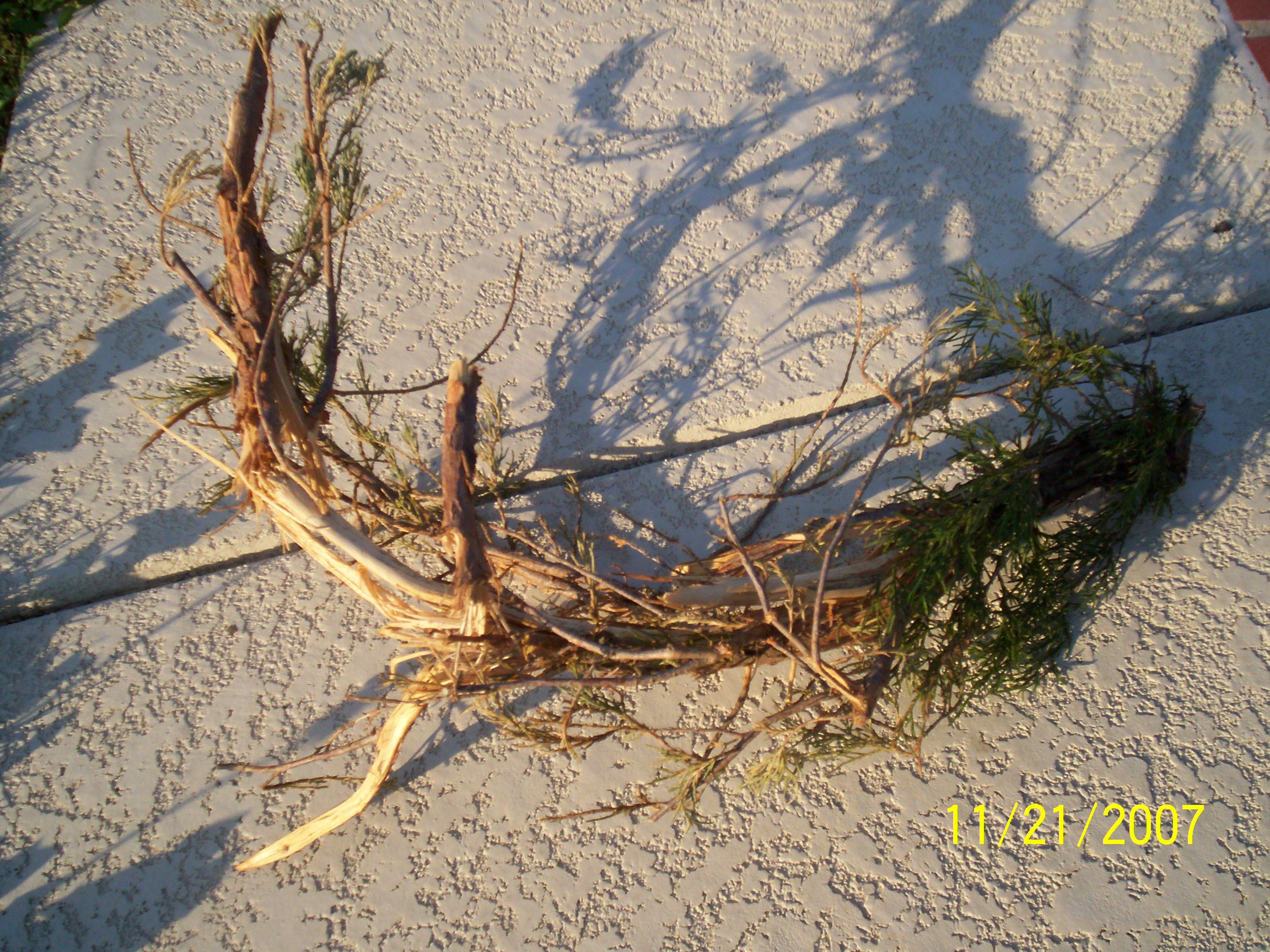 5. One of the lower limbs exhibited significant damage, and had been broken and splintered in several locations where numerous hairs were trapped in the breaks. We cut this limb off the tree and took it for further examination.
5. One of the lower limbs exhibited significant damage, and had been broken and splintered in several locations where numerous hairs were trapped in the breaks. We cut this limb off the tree and took it for further examination.
6. To our knowledge, no one saw the animal/creature do the damage to the tree or deposit the hairs on the tree.
7. At no point during the recovery of the hair did we find or notice any teeth or claw marks. Also lacking was any sign of saw or hatchet cut marks anywhere on the tree.
8. The hairs can be described as being brown to black in color, wavy, fine in diameter, and range from 2 to 7 inches in length. They had a shiny appearance when observed on the tree in daylight. Under the microscope, the hairs exhibit a prominent medulla with an index of around .5 (human hair medulla .33 when continuous), and with dark evenly distributed pigment. Numerous hairs are complete from root to a naturally tapered end. We have not to date, found any of the hairs to have been cut with a razor or clippers.
9. The number of individual hairs collected were so numerous we didnít count them, but is estimated to be over one hundred.
How the specimens were collected and stored:
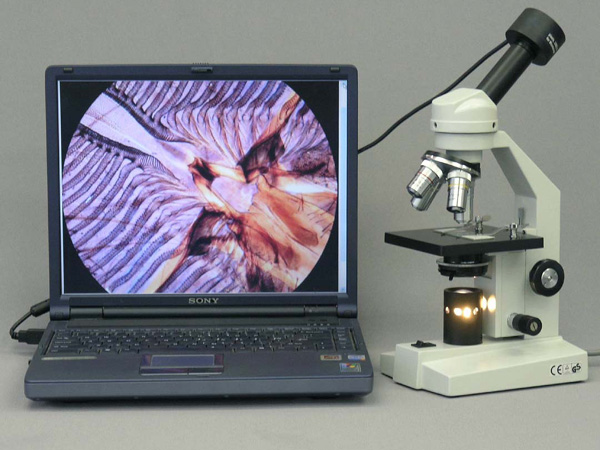 1. None of the hairs in this sample were touched by human hands during the recovery process or at any time since.
1. None of the hairs in this sample were touched by human hands during the recovery process or at any time since.
2. All hairs that were removed from the tree in the field were touched by tweezers or hemostats only, which had been cleaned with rubbing alcohol.
3. All hairs were placed in dry paper bags for transport and storage.
4. All hairs have been stored since recovery in a climate controlled location inside the paper bags and have not been removed except to periodically send off samples.
5. We have retained enough of the sample that we could supply several additional rounds of DNA tests if necessary.
6. A small portion of the collected samples were separated from the rest to allow for our own analysis. Using our microscope we took photos and hair casts, some of which are what you see on this page.
Primary discussion points:
We have found Cedars with this type of damage in other areas we have been researching, so much so that damage to Cedars is something that we look
for whenever we are in the field. When the limbs have been broken long enough they turn a burnt red color that is easy to spot from a distance, the
fact that we had seen this before is what tipped us off to have a close look at the tree in the pictures. In the months following the find,
samples of the hair were sent to four different labs for analysis with our initial objective and expectation being to determine if the hair might
be from domesticated animals such as cattle, horse, dog, etc. If it turned out to not be any of these then we expected the hair might come back
as Black Bear in origin even though our witness was adament that there have been no Bear sightings coming out of the area. Black Bear are
established in Oklahoma but they are mostly concentrated in the South Eastern corner of the state. Approximately 120 miles East of this research
location.
Samples were either sent or delivered in person to Dr. Henner Fahrenbach, Dr. Lynn Rogers and staff at the Wildlife
Research Institute(WRI) in Minnesota, the Sam Noble Museum of Natural History in Norman, Ok. and a fourth lab was employed to attempt
to pull DNA sequences from any skin tags that might be attached to the samples. The name of this lab will be withheld due to the
person doing the testing being an aquaintence of the researchers and the fact that they were doing the testing free of charge, thus the testing did not
have the normal statement of authenticity nor official report attached to the results. The results, depending on what they were, would strictly be
used to justify if further analysis should be pursued on the sample.
Dr. Fahrenbach responded with his results first and claimed that without a doubt the sample was Black Bear. We found this interesting and would be a significant find if we could confirm it, so we sent a sample to Dr. Lynn Rogers to have Dr. Fahrenbach's indentification confirmed. Things got more interesting when WRI responded:
"The hair you sent is not black bear hair -- I know that much. I have included a sample of black bear hair for comparison. I really don't have a clue what it could be. I suggested bovine tail hair because of the length -- but I haven't a sample of bovine tail hair to compare it with. The hair you sent is pretty fine stuff -- and long. I can't think of a wild animal with hair that long."
Next to respond was the Sam Noble Museum Department of Mammalogy, they reported:
"We don't feel confident in properly identifying it, but we know that it is not a bison, or bear (although I really wanted it to be bear hair, how exciting)."
Again it was found that the most likely culprit, Black Bear, was also not found to be a match as we had originally expected.
Finally, in another attempt to find out what exactly we had we engaged our contact that had access to a testing facility to try and pull a DNA sequence if possible from skin tags still attached to the hairs. In this case whatever sequence was extracted (if any) would be compared to the entire library of known samples held in the computer system in this lab. This would include domestic animals as well as most wild animals indigenous to this region. After several days of testing we received an email from the technician which read in part -
"Yeah, 3 of the skin tags retrieved from the samples did not match or "NO MATCH FOUND" according to computer analysis. Weird, huh? As far as I can tell, I can't match the sequencing codes exactly to any animal/human. This can be due to a number of reasons, however, the skin tags appeared in really good shape. I'm not officially allowed to say that they belong to a squatch but another explanation is highly unprobable given the location, time of year, and the appearance (size, shape, color, thickness, etc.)."
When queried that it was not even a match to Black Bear our contact responded with the following:
"Actually black bear is the first thing that was ruled out. Microscopically, the hairs do have a consistency that is similar to bear, but they are genetically different. I know, I was surprised too. I'm baffled but as I've learned through years of lab work you can not argue with science."
In April of 2010 we decided to send about 1/2 dozen hairs to Dr. Melba Ketchum as the word got out that she was accepting samples for examination to see if there was anything to be determined from hairs that were said to defy classification as a known animal. The plan was to submit these samples to rigourous morphological exam by a designated hair specialist and if the hair remains unidentified then to proceed with DNA testing.
Depending on the DNA results turning out to be from the genus homo, these hairs might be considered human. Though, with all observations considered, the hairs would have had to come from a humans head, as this would logically be the only part of a human that would normally be exposed to pick up cockle burrs (Xanthium strumarium) and grow hair to the length observed. Given that the hairs exhibit natural tapered ends, the person would either have to be a child not having had their first hair cut or a person who routinely pulls their hair out by the root instead of getting it cut. This would not only have to be true to explain these hairs being found with roots, but would have had to have occurred 10 months prior also (using 5 inches as an average length and .5Ē per month growth rate) to explain the naturally tapered ends and the length. Hairs will grow back after being pulled out and will have natural tapered ends until they are cut or broken by other means. These facts coupled with the deliberate damage to the tree, and morphology of the hairs suggests strongly that this was not normal human behavior nor likely human hairs or spoor.
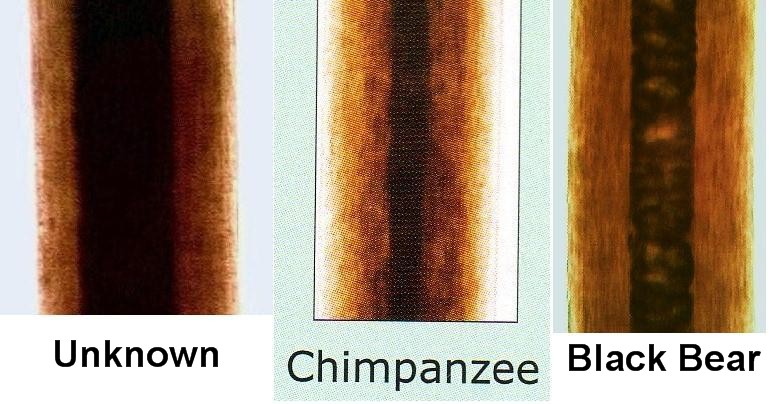 Hair is made up of dead cells that do not change in appearance once they are extruded from the skin. This means that hairs will retain their
structure and appearance even when detached from the animal. Further, hair is consistent in appearance among members of the same species
(i.e the hair from the pelt of one rabbit will look the same as hair from the same place in the pelt of all rabbits). A consequence of this
is that hairs collected during research outings can be examined and compared with hairs from identified animals indigenous to the area.
The comparison of unknown hair samples with known hair samples forms the basis of hair analysis.
Hair is made up of dead cells that do not change in appearance once they are extruded from the skin. This means that hairs will retain their
structure and appearance even when detached from the animal. Further, hair is consistent in appearance among members of the same species
(i.e the hair from the pelt of one rabbit will look the same as hair from the same place in the pelt of all rabbits). A consequence of this
is that hairs collected during research outings can be examined and compared with hairs from identified animals indigenous to the area.
The comparison of unknown hair samples with known hair samples forms the basis of hair analysis.
The photos above and to the right are a list of possible suspects for the hair donor when we started this investigation. The list includes domestic
animals such as Equine, Bovine, Dog and wild animals such as Fox, Coyote, Black Bear and even Bison. The appearance at first glance would seem that
the hair might well have been left by an animal common to the area, and from its gross appearance when examining with the naked eye would suggest
that the hair most likely would have come from either a horse or cow that had escaped from a nearby ranch. And failing that, perhaps from Black
Bear due to Oklahoma having a thriving population of Ursus americanus. Ultimately, all of these possible matches were eliminated as the donor by reasoning
that diffences become apparent under magnification and the labs we submitted to should be competent in identifying common animals.
Animal hair has several diagnostic qualities, these include color, length, diameter, presence or lack of a medula, meduliary index
(when present), scale pattern type, shape and appearance of the hair cross section and finally the degree of wave. Consensus among
those labs used to examine our samples to date is that this donor remains unidentified.
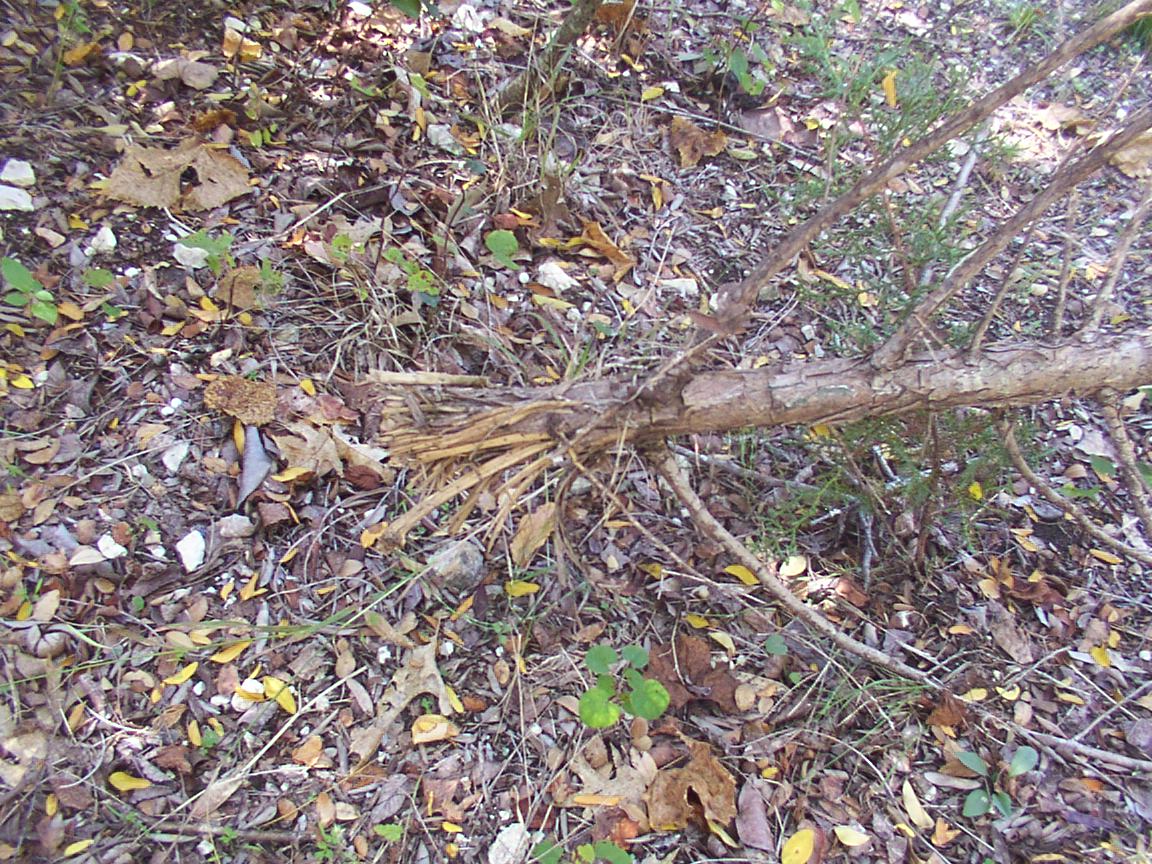 The photos at the bottom of the page are respresentative of damage to Eastern Red Cedars that we have photographed in various
research areas. Major damage to these trees was not easily attributed to known weather events, since trees standing right next to
these show no damage at all. Many have limbs that are tucked or bent underneath other limbs in such a way that it would appear to
require hands to manipulate them in the way observed. In some cases the tops of small cedars have been twisted off and apparently thrown
or carried some distance away (photo to the right). In this case it was not so much a twisting action as a rocking action, which was done to the point
that the tree top was removed, we found the top about 20 feet away. This tree top was collected by the group and was inspected closely for signs
of hair or clues left by whatever removed it. Nothing was found that indicated that the tree was broken by typical means, i.e. no
signs of hatcheting or saws being used nor any sign of chains or heavy equipment. There were no scrapes, scratches or teeth marks found. No indication that
it was exploded by lightening, no signs of being burned were present. In fact it is devoid of even small branches being broken off above the break
as someone or something with large hands might have done while they wrenched the tree around during this operation. Whatever did this managed to
not leave a mark in the process.
The photos at the bottom of the page are respresentative of damage to Eastern Red Cedars that we have photographed in various
research areas. Major damage to these trees was not easily attributed to known weather events, since trees standing right next to
these show no damage at all. Many have limbs that are tucked or bent underneath other limbs in such a way that it would appear to
require hands to manipulate them in the way observed. In some cases the tops of small cedars have been twisted off and apparently thrown
or carried some distance away (photo to the right). In this case it was not so much a twisting action as a rocking action, which was done to the point
that the tree top was removed, we found the top about 20 feet away. This tree top was collected by the group and was inspected closely for signs
of hair or clues left by whatever removed it. Nothing was found that indicated that the tree was broken by typical means, i.e. no
signs of hatcheting or saws being used nor any sign of chains or heavy equipment. There were no scrapes, scratches or teeth marks found. No indication that
it was exploded by lightening, no signs of being burned were present. In fact it is devoid of even small branches being broken off above the break
as someone or something with large hands might have done while they wrenched the tree around during this operation. Whatever did this managed to
not leave a mark in the process.
